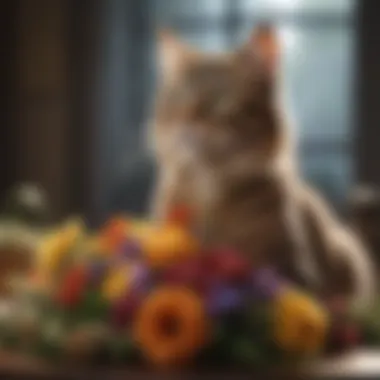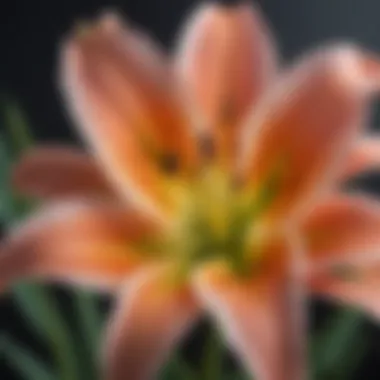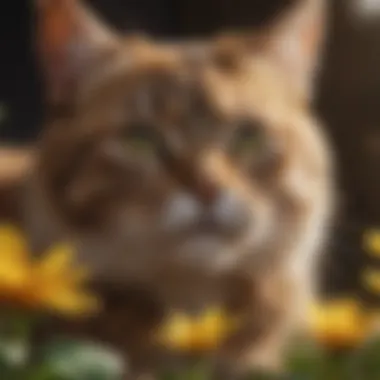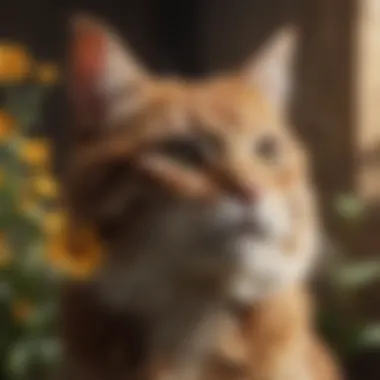Understanding the Dangers of Common Flowers for Cats


Intro
Creating a safe environment for cats is essential for their health and wellbeing. Understanding common flowers that can be toxic to these beloved pets is crucial. Every year, many cats suffer from the ingestion of household plants. This guide outlines the flowers that pose risks, the symptoms that arise from their consumption, and preventive measures to keep felines safe.
The Importance of Plant Safety
As lovable companions, cats are naturally curious. This curiosity often leads them to explore their surroundings, including the plants we keep at home. Certain flowers can be poisonous, leading to serious health implications.
Equipping cat owners with knowledge about these hazards builds a safer home for both pets and people. Providing alternatives that are safe and visually appealing can enhance the aesthetic experience without risking the cat's health.
Fascinating Facts About Cats
Unique Characteristics
Cats have a wonderful sense of smell, which is far superior compared to humans. This ability can lead them to flowers or plants that attract their interest. However, the sensitivity of their digestive system can lead to adverse reactions, including vomiting and diarrhea if they consume toxic flowers.
Extraordinary Abilities
Additionally, cats possess a remarkable agility. This trait can have them reach high shelves or tables where plants may be kept. Thus, it is essential that all harmful flowers be kept out of their reach to avoid potential ingestion.
Recognizing Toxic Flowers
Understanding which flowers are harmful can help prevent accidents. Some common toxic flowers include:
- Lily: Can cause severe kidney damage.
- Azalea: Ingestion can lead to vomiting and lethargy.
- Oleander: It can disrupt heart function.
- Chrysanthemum: Symptoms include diarrhea and skin irritation.
Identifying symptoms of ingestion is equally important. Symptoms can be:
- Vomiting
- Diarrhea
- Lack of appetite
- Abdominal pain
- Lethargy
It's vital to act quickly if a cat shows signs of toxicity to any flower. Consult your veterinarian immediately.
Preventive Measures
To keep cats safe from toxic flowers, it is important to take the following steps:
- Identify toxic plants within the home.
- Educate family members about plant safety.
- Consider non-toxic alternatives such as spider plants or bamboo palms, which are safe and attractive for home decor.
By being proactive, you can create a safe space for your feline and enjoy the beauty of flowers without fear.
The End
Being aware of the dangers that common flowers pose to cats is critical for any responsible pet owner. With proper knowledge and care, it is possible to enjoy a vibrant home filled with plants while keeping your furry friend safe.
Preamble
The safety of cats in environments where flowers are present is a crucial concern for pet owners. Understanding the impact of common flowers on feline health helps in preventing potential harm that may arise from their curiosity. Cats have a natural instinct to explore their surroundings, and this can lead them to investigate and sometimes consume plants that are toxic to them.
Education on the dangers posed by certain flowers can foster a safer home for both pets and their owners. Recognizing the plants that are hazardous allows for informed decisions when selecting decorative flora for living spaces. This not only enhances the aesthetic of a home but also minimizes the risks associated with toxic ingestion.
Knowledge of the signs and symptoms of flower poisoning is essential. Early detection can significantly improve the chance for effective treatment, should a cat ingest a harmful substance. This article will delve into the specific flowers that pose dangers to cats, outlining their effects, the symptoms to watch for, and suggestions for safer alternatives. Proper understanding and prevention can lead to healthier and safer living environments for our feline companions.
The Importance of Plant Safety
Plant safety is a crucial consideration for households with cats. Many common flowers, while visually appealing, pose significant health risks to our feline companions. By understanding these dangers, we can better protect our pets and create a safer environment for them.


When we talk about plant safety, it is essential to recognize that cats are inherently curious creatures. They explore their surroundings through smell and taste. This natural behavior can lead them to nibble on flowers or plants, sometimes with dire consequences.
Understanding Feline Behavior
Cats are known for their inquisitive nature. They spend a considerable amount of time investigating their environment. This behavior includes sniffing and sometimes chewing on plants. A cat's curiosity can lead it to explore various parts of a flower, from petals to stems. Unfortunately, this can also result in exposure to toxic substances. Many cats do not recognize harmful plants, leaving them at risk of poisoning.
To illustrate this point, consider the example of lilies. Just the pollen or small fragments of the plant can pose a fatal risk to cats. Therefore, understanding feline behavior is key to mitigating risks in your home.
Household Risks
The presence of toxic plants in our homes does not just endanger our cats. It can also create an environment where other pets or children might inadvertently become involved.
Some common risks that arise from having toxic plants include:
- Accidental ingestion: Cats may accidentally consume parts of a plant, leading to potential poisoning.
- Poor plant care: Neglected plants can harbor mold or other pathogens that may affect cat health.
- Landscaping decisions: Homeowners may not realize that certain outdoor plants pose a threat, especially if cats have access to those areas.
It’s important for pet owners to be vigilant. Regular checks of the plants in your space is necessary to ensure they are either non-toxic or not accessible to cats. Knowledge about plant types can greatly reduce the risk of poisoning by helping owners make informed decisions about their floral choices.
In summary, understanding plant safety is vital for maintaining a healthy and safe living space for our cats. With proper knowledge and observation, we can significantly reduce potential hazards while still enjoying the beauty of nature indoors and outdoors.
Common Toxic Flowers for Cats
Understanding common toxic flowers for cats is critical for any pet owner. Many of us enjoy the beauty of flowers in our homes and gardens, yet some of these plants pose significant health risks to cats. Identifying these plants can aid in preventing accidental poisoning and ensuring a safer living environment for our feline companions.
The key characteristic of toxic flowers is their potential to cause severe health issues. For instance, certain flowers like lilies can result in kidney failure, while tulips and daffodils can lead to gastrointestinal distress. Knowing these risks helps in fostering a pet-friendly environment. It is not just important for the cats, but also for peace of mind among cat owners.
Moreover, discussing the effects of ingested flowers facilitates understanding of the necessary responses in case of exposure. This forms an essential part of responsible pet care, which includes selecting the right plants.
Lilies
Types of Lilies
Types of lilies are particularly noteworthy due to their widespread popularity and substantial toxicity. Common varieties, such as the Easter lily, the Tiger lily, and the Asiatic lily, are all highly toxic to cats. The danger with these flowers is not only their beauty but also their frequent presence in homes and gardens.
A crucial aspect of lilies is that they can cause acute renal failure in cats. Their presence raises the stakes for any cat owner, as even small ingestions can lead to significant health consequences. Unlike other plants that might cause mild symptoms, lilies can have life-threatening effects very quickly. To keep cats safe, awareness of these specific lily types is essential for all pet owners.
Symptoms of Ingestion
Symptoms of ingestion play an important role in recognizing when a cat has consumed toxic plants. Ingestion of lilies can result in vomiting, lethargy, and decreased appetite within hours. As time progresses, more severe symptoms, like kidney failure, can manifest.
Notably, early recognition of these symptoms significantly Improves the chances of recovery. If symptoms appear, contacting a veterinarian immediately is crucial. Knowledge of these indicators can empower cat owners to act promptly, illustrating the importance of awareness regarding lilies' toxicity.
Tulips
Tulip Petals and Bulbs
Tulip petals and bulbs also present risks that many people may overlook. While the petals might seem harmless, the bulbs are highly toxic. These bulbs contain compounds that can cause serious health issues for cats, making them a significant concern for pet owners who enjoy gardening.
Tulip bulbs are particularly dangerous because they attract curiosity from pets. Their appealing shape can entice cats to dig and nibble, leading to potential poisoning. This aspect makes awareness of tulip placements essential. Encouraging safe gardening practices can prevent accidental ingestion.
Health Risks
Health risks associated with tulip consumption are serious. In cats, ingestion can lead to symptoms such as drooling, vomiting, diarrhea, and in severe cases, respiratory distress. Understanding these risks is beneficial for anyone considering planting tulips. Preventative actions can be taken to ensure that these flowers do not pose a danger to cats. Monitoring garden spaces for any potentially toxic bulbs is essential for maintaining safety.
Daffodils
Effects of Daffodil Consumption


Effects of daffodil consumption can be severe. All parts of the daffodil plant contain toxic substances, most notably a compound called lycorine, which can trigger nausea and vomiting in cats. Understanding how this plant affects feline health is vital for cat owners who wish to maintain a safe home environment.
The toxic effects are not just immediate, but they can lead to severe abdominal pain and discomfort. Preventing access to daffodil plants is essential to ensure that cats are not exposed to these risks.
Signs of Poisoning
Signs of poisoning from daffodil consumption include gastrointestinal upset, which can manifest as vomiting, diarrhea, or even seizures in severe cases. Knowing these signs allows pet owners to act decisively if their cat shows symptoms of ingestion. Recognizing these signs quickly can lead to faster veterinary intervention, improving the outcome significantly during critical early hours.
Chrysanthemums
Common Reactions
Common reactions to chrysanthemums in cats can vary from mild to severe. When ingested, symptoms like vomiting, diarrhea, and loss of appetite may occur. These plants contain pyrethrins, which are toxic compounds that affect the digestive system and neurological functions. Understanding these reactions is crucial for any responsible cat owner who might grow these flowers.
Treatment Options
Treatment options for chrysanthemum ingestion often include inducing vomiting or administering activated charcoal to limit toxin absorption. Seeking immediate veterinary care can help mitigate the toxic effects. The rarity of serious complications, however, underscores the importance of responding to early signs and symptoms. Effective treatments can often lead to complete recovery if administered timely.
Rhododendrons
Symptoms and Severity
Symptoms and severity related to rhododendron ingestion are essential to understand. Toxicity stems from grayanotoxin present in the plant, which can lead to gastrointestinal issues, including vomiting and diarrhea. In severe cases, it can also cause central nervous system effects, emphasizing the need for vigilance when these plants are present in a household with cats.
Immediate Actions
Immediate actions are necessary if ingestion occurs. Call a veterinarian without delay and provide details about the plant and symptoms. Promptness in taking action is crucial, as prompt treatment can increase recovery chances. Having emergency numbers available can assist pet owners in critical situations, ensuring favorable outcomes.
Other Notable Toxic Plants
Foxglove
Foxglove is another well-known plant that poses risks. Its toxicity arises from compounds called cardiac glycosides. These can lead to serious heart conditions or even death if ingested in sufficient quantities. It is vital for cat owners to recognize this flower and prevent access to it.
Azaleas
Azaleas also should be avoided. They contain substances that can cause gastrointestinal upset, lethargy, and even cardiovascular issues. Education and awareness about these plants is fundamental in promoting a safe and healthy environment for cats. By steering clear of pet-toxic plants like azaleas and foxglove, cat owners can minimize potential health risks.
Symptoms of Flower Poisoning
Understanding the symptoms of flower poisoning in cats is crucial for any pet owner. Cats, being curious by nature, often engage with their environment through exploration. Flowers, whether outside in the garden or inside as decorations, can easily become targets of their curiosity. Recognizing the early signs of poisoning can make a significant difference in the health outcomes for a cat. Being aware of these symptoms can help in immediate action and treatment, which can be life-saving. The symptoms may vary depending on the flower type and the amount ingested. Therefore, keeping informed helps in reducing risks and providing a safe environment for feline companions.
Common Symptoms in Cats
Cats displaying symptoms of flower poisoning may exhibit a range of behavioral and physical changes. Here are a few common symptoms to watch for:
- Vomiting: A frequent response to ingestion of toxic plants, often accompanied by loss of appetite.
- Diarrhea: Changes in bowel movements can occur, indicating digestive distress.
- Lethargy: An overall lack of energy can signal health issues. If a cat seems unusually tired or withdrawn, it’s worth considering.
- Drooling: Excessive salivation may occur. This can be a direct response to irritation in the mouth or throat.
- Difficulty Breathing: If a cat shows signs of respiratory distress, it could indicate serious poisoning.
- Seizures: This is less common but can be life-threatening. A seizure may indicate severe toxicity.
These signs can often overlap with other health issues. Therefore, detailed observation is necessary to assess whether the cat may have ingested a toxic flower.
When to Seek Veterinary Care
It is vital to seek veterinary care as soon as possible if a cat shows symptoms of flower poisoning. Professional help can prevent a worsening condition and increase the chances of recovery. Here are situations that require immediate attention:
- Multiple Symptoms: If your cat displays more than one symptom concurrently, it may indicate a more significant problem.
- Persistent Vomiting or Diarrhea: If these symptoms do not resolve quickly, they can lead to dehydration.
- Severe Lethargy: If the cat shows extreme fatigue and is unresponsive to stimuli, seek help.
- Breathing Issues: Difficulty breathing can escalate rapidly and needs urgent veterinary evaluation.
- Known Contact with Toxic Plants: If you suspect your cat has ingested a known toxic flower, do not wait for symptoms to appear. This is a medical emergency.
In many instances, a quick reaction is critical to ensuring the safety and health of a cat. Keeping emergency contact information for a veterinarian readily accessible is wise for any pet owner.


Always prioritize your cat's well-being. Understanding symptoms and knowing when to seek help can protect your beloved pet from serious harm.
Preventive Measures
Preventive measures are essential when discussing the potential risks that common flowers pose to cats. Various flowers and plants can cause serious health issues in felines, so understanding how to mitigate these threats is vital for pet owners. Prioritizing safety enhances the quality of life for both cats and their owners. By making informed choices about plants and flowers in the home, one can significantly reduce the chances of accidental ingestion, which is often a cause of poisoning in cats.
Taking proactive steps in choosing safe plants can protect cats from potential dangers. This means being aware of which flowers are toxic and cultivating a pet-friendly environment. Additionally, familiarizing oneself with safe care practices can help maintain the safety of indoor plants. By doing so, pet owners not only safeguard their cats but also foster a healthier household.
Choosing Safe Plants
Selecting safe plants for homes with cats requires thorough research. Many well-known flowers may pose toxicity risks. Some flowers that are safe for cats include:
- Orchids: Beautiful and non-toxic, orchids are an excellent option.
- Spider plants: These are resilient and safe for feline companions.
- Bamboo palm: This plant provides both safety and aesthetic appeal.
When considering new flora, always consult reliable sources. Resources like the ASPCA's list of toxic and non-toxic plants can provide valuable information. Pet owners should opt for plants recognized as safe to minimize risk. Additionally, focusing on native plants can lead to safer choices, as those are generally well-studied in local environmental contexts.
Indoor Plant Safety Tips
Maintaining safety around indoor plants involves various strategies. Proper placement and care can help reduce risks significantly. Here are some important tips:
- Placement: Keep plants out of reach of curious cats. Shelves or high places can deter them from access.
- Education: Teach family members about which plants are safe and which are not. This ensures everyone is vigilant.
- Immediate action: If you suspect your cat has ingested a potentially toxic plant, seek veterinary care right away. Quick responses can save lives.
Another helpful tip is to monitor the environment regularly. Keeping an eye on your plants will allow you to assess their condition and ensure they pose no threat. By integrating these preventive measures, you create a safer living space for your feline friends while enjoying the beauty of indoor flora.
Non-Toxic Flower Alternatives
Non-toxic flower alternatives are crucial for creating a safe environment for cats while still being able to enjoy the aesthetic benefits of plants. Choosing safe floral options helps reduce the risk of accidental poisoning and keeps our pets healthy. When selecting plants, it is important to consider not only their visual appeal but also their compatibility with the well-being of cats.
Safe Floral Options
Sunflowers
Sunflowers are a popular choice in many households due to their bright, cheerful appearance. They belong to the Helianthus genus and are well-known for their large yellow petals and green centers. One key characteristic of sunflowers is their non-toxic nature to cats. This makes them an excellent option for pet owners who want to add color without endangering their furry friends.
A unique feature of sunflowers is their tall stature, which can range from 3 to 12 feet in height. This makes them suitable for gardens or as decorative indoor plants. The advantage of having sunflowers is that they are relatively easy to grow, and they also attract pollinators like bees and butterflies, promoting biodiversity in the area. However, it is worth noting that some cats are attracted to the seeds, which can lead to overeating. Moderation is key.
Petunias
Petunias are another safe flower option for homes with cats. They are part of the Solanaceae family and are characterized by their wide variety of colors and patterns. The primary appeal of petunias is their ability to bloom continuously during the growing season, providing lasting beauty. Moreover, they are not toxic to cats, making them an ideal choice for pet-friendly gardens.
Petunias come in trailing and upright varieties, allowing for versatility in planting arrangements. Their fragrant flowers can enhance indoor or outdoor spaces, adding an appealing scent. One downside is that they may attract certain pests, which could lead to the need for careful management. Overall, petunias offer both visual enjoyment and peace of mind regarding pet safety.
Marigolds
Marigolds are well-respected for their vibrant colors and hardiness. Belonging to the Tagetes genus, marigolds are easy to cultivate and can thrive in various environments. They are celebrated for their bright orange and yellow hues, which can liven up any space. Importantly, marigolds are non-toxic to cats, providing reassurance for pet lovers.
A unique feature of marigolds is their pest-repellent properties. They are sometimes used in gardens to deter harmful insects, which is an added benefit for those who grow vegetables or other plants. While marigolds do not pose a health risk to cats, their strong scent might be off-putting to some felines. Therefore, positioning them thoughtfully in your home or garden could enhance both aesthetics and safety.
In summary, non-toxic flower alternatives such as sunflowers, petunias, and marigolds can provide beauty without the associated risks of toxicity for cats. Selecting these flowers reflects a careful consideration of the environment for both aesthetic enjoyment and pet safety.
Ending
The issue of flower toxicity to cats must not be underestimated. The dangers posed by common houseplants can significantly impact the health and well-being of feline companions. Through this article, it has become clear that awareness of which flowers are harmful is critical for pet owners.
Summary of Key Points
- Common Toxic Flowers: Knowledge of specific flowers like lilies, tulips, and daffodils is essential. Each type has distinct symptoms and risks associated with ingestion.
- Symptoms of Poisoning: Recognizing the signs such as vomiting, diarrhea, or lethargy can be vital for timely intervention. Prompt veterinary care can save lives.
- Preventive Measures: Choosing safe plants and implementing indoor plant safety tips is crucial. This reduces the risk of accidental ingestion.
- Non-Toxic Alternatives: There are many beautiful flowers that are safe for cats, such as sunflowers and petunias. Understanding these options allows for an aesthetically pleasing yet safe environment.
Encouragement for Pet Safety
Pet owners must prioritize the safety and health of their furry friends. When selecting flowers or plants, always conduct thorough research. If unsure about a particular species, it is wise to consult with a veterinarian or refer to reliable sources. Additionally, educating all family members on the potential dangers of certain flowers can prevent accidental exposure.
With a proactive approach, it is possible to enjoy the beauty of plants and protect the well-being of pets. It is a shared responsibility to ensure that our homes remain safe havens for our beloved felines.







